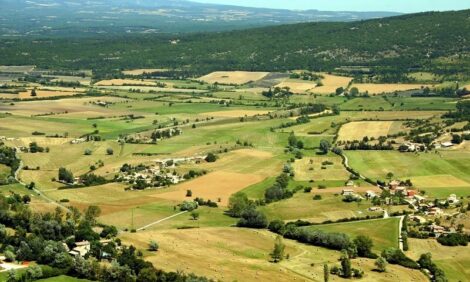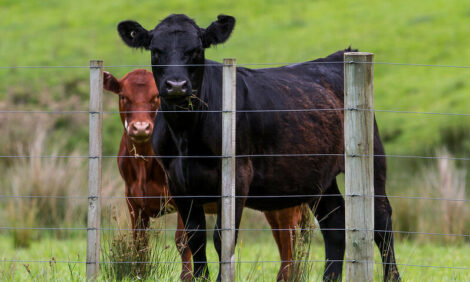



Climate variability challenges US cattle producers
Mother Nature provided increasingly inconsistent precipitation for the Great Plains over the past decade, impacting grasslands, forage systems and beef production in the region—and scientists expect that trend to intensify.Texas A&M AgriLife Research scientists and collaborators explored the rural economic impacts of climate variability and identified potential future outcomes for beef cattle production in a research article, “Future climate variability will challenge rangeland beef cattle production in the Great Plains,” recently published in the journal Rangelands.
David Briske, Ph.D., AgriLife Research rangeland ecologist in the Department of Ecology and Conservation Biology in the College of Agriculture and Life Sciences at Texas A&M University, Bryan-College Station, was the lead author. Coauthors were John Ritten, Ph.D., University of Wyoming; Amber Campbell, Ph.D., Kansas State University; Toni Klemm, Ph.D., AgriLife Research post-doctoral research associate; and Audrey King, Ph.D., Oklahoma State University.
The researchers concluded the key to sustainable beef cattle production on the Great Plains is being prepared for, rather than reactive to, climate change in the region and hope their article can guide discussions and encourage future action.

Climate variability increasing across Great Plains
Climate change is often perceived as a gradual long-term change in weather such as precipitation and temperature. But future weather patterns in the Great Plains may be characterized by increased precipitation variability, or increased instances of wet or dry years and fewer “normal years,” Briske said.
Increased precipitation variability will have broad consequences for the region, but agriculture and rural economies may be the most vulnerable, Briske said. Cattle operations, which rely on grassland forage for much of their animals’ dietary intake, could be especially vulnerable to increased precipitation variability.
The Great Plains contain the largest remaining tracts of grassland and 50% of the nation’s beef cows, more than 16 million head, representing major components of the region’s overall agricultural economy. Beef cattle production contributed $43 billion to state and local economies across the Great Plains in 2017.
In Texas alone, beef cattle and calves generate the largest total contribution among agricultural commodities for the state — $8.566 billion in cash receipts alone, according to a 2020 Texas A&M AgriLife Extension Service economic impact study focused on food and fiber production.
Precipitation variability greatest in southern Great Plains
A key impact of increased precipitation variability is on the grassland forage production that supports cow/calf production throughout the region. Researchers are looking at the past, present and future climate projections and the consequences increased variability could have on sustainable beef production.
“Greatest emphasis has focused on the change in total annual rainfall, but what is most striking is the increase in inter-annual variability – the phenomenon where we go from a couple of years of drier-than-normal to flooding and then back to drought and so on,” Briske said.
It’s important to recognize that this is different than dealing with drought alone, he said.
“I do not wish to be alarmist, but we do want to present this message in an ag-production context so that the industry can prepare to offset the impact of greater weather variability on individual producers, grassland conservation and rural economies.”
The research indicates the number of deficit forage years for the southern Plains, which includes Texas, Kansas and Oklahoma, increased from two years per decade to three years, four months per decade and remained at two years for the northern Plains. The number of abundant forage years increased from two to five years per decade in the northern Plains and from two to three and half years in the southern Plains near the end of the century.
This indicates that beef producers will experience a greater number of years where annual forage production may vary by 50%. This increases the already difficult task of balancing forage production with cattle demand. Briske said this increasing weather variability could present sustainability problems for beef cattle operations and regions that have been successful historically.
This variability will negatively impact the economic viability of beef cattle production and the sustainability of grasslands by creating conditions for overgrazing, he said. But effective adaptations that could help cattle producers minimize impacts require greater consideration.
Deeper culling and liquidation of cattle herds during drought years and then restocking in normal or wet years creates the greatest economic hardship for beef producers, Briske said. Researchers emphasized the need for adaptations that will minimize grassland overgrazing and the need to undergo costly destocking-restocking cycles as being most critical.
But current climate adaptations, including proper stocking rates for conservative grazing, grass banking and water development, may be insufficient to offset the negative economic impacts of future precipitation variability, he said. The research suggests beef cattle production could be gradually shifting from southern Plains states like Texas toward the central and northern Plains.
For example, Briske said, the Dakotas and Nebraska gained 403,000 cows between 2010 and 2020, while Texas lost 570,000.
Sooner is now
The researchers emphasized the need to act sooner than later and to incorporate ideas from multiple societal sectors outside agriculture in support of sustainable grassland beef production.
Action begins by shifting stakeholders’ perspective to a proactive rather than reactive response to severe weather events like drought and flooding, Briske said. Preparedness will require anticipating threats to the sustainability of beef cattle production throughout the Great Plains on both macro- and micro-scales.
Beef cattle producers in the southern Plains were surveyed as part of this research. The majority indicated they were aware of, but uncertain about, future climate impacts, which suggests they would benefit from assistance to develop and implement appropriate adaptations, Briske said.
Suggesting stakeholders should act now rather than wait for crisis, he said the initial conversations about the potential impacts of increasing weather variability could be spearheaded by trade groups and the beef cattle industry that have political clout at all levels of government. The beef cattle and livestock industry coalitions could make legislators aware that changes in state and federal policy regarding sustainability in future climates should be a top priority now and into the future.
“The key is to begin planning and investing in adaptation strategies during good years,” he said. “The region will likely experience an increasing number of wet and dry years in the future. The question is whether the industry and rural regions will be prepared.”



